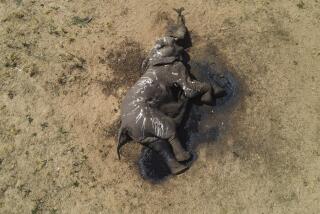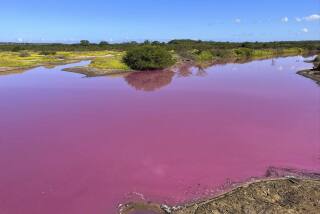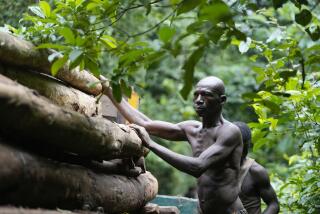Toxic Waste, Untreated Sewage Reportedly Killing Wildlife in Kenya Game Reserve
- Share via
LAKE NAKURU, Kenya — Hundreds of wild animals are being killed by toxic waste and untreated sewage being dumped into one of Kenya’s top game reserves, wildlife officials say.
Beer bottles, condoms, plastic, paper and old clothes litter the shores at Lake Nakuru National Park, once famous for its flocks of pink flamingos.
Now the flamingos appear to have been driven away by the filth and stench--and park wardens fear for the rest of the wildlife in their charge.
“The animals are in great danger, but all we can do is sit and wait,” said Assistant Warden Jane Kahata.
Wildlife officials say that hundreds of the antelopes and wart hogs that graze on the lake shores have died and that vultures and hyenas--nature’s least choosy scavengers--leave the rotting carcasses untouched.
Wardens say more than 500 waterbuck from a population of 4,000 have perished in just the last two months.
The acrid smell of decomposing carcasses fills the air in the northern part of the park.
“We try to remove the carcasses as soon as we discover new ones. We do not want to keep away tourists,” Kahata said.
Wildlife officials say the lake is the dumping ground for rubbish from the nearby industrial town of Nakuru, about 125 miles northwest of Nairobi, the Kenyan capital.
Factory waste and untreated sewage is being poured directly into the lake, they say.
With the onset of the breeding season last year, thousands of flamingos flew to their traditional nesting grounds on lakes in the neighboring Great Rift Valley.
Experts say the birds should have returned months ago, and may have been deterred by Lake Nakuru’s pollution.
Some government officials deny that the animal deaths are caused by pollution and say that they have been caused by overpopulation.
The reduction in numbers will ease competition for food, they add.
But the state-run Kenya Wildlife Service, set up last year to end years of corrupt mismanagement of the country’s dwindling wildlife resources, says there is a pollution problem at Lake Nakuru.
“Everybody knows and is concerned about the effluent from Nakuru town,” said Joe Kioko, deputy director of the wildlife service. “It’s rubbish for civic authorities to pretend the pollution problem is not there.”
He said culling animals to reduce the population had not been carried out at Lake Nakuru because nobody was sure if overcrowding was taking place.
“There could be other environmental reasons which we have not yet found out. All these require funds, but we have tried our best,” Kioko said.
Wildlife officials say some visitors have curtailed vacations at Lake Nakuru because of the dead animals.
Kenya, which boasts 59 wildlife parks, earned $378 million from tourism in the 1989-90 financial year, more than any other sector of the economy.
The government is desperately concerned about the tourism industry amid a big falloff in visitors caused by the Gulf crisis, which prompted many people to forgo international travel out of fear of terrorism.
The 138-square-mile Lake Nakuru is Kenya’s second most profitable park, according to officials. Once part of a natural paradise of savannah, swamps and forests, it is now hemmed in on all sides by urban development and farmland.
It is one of the few game preserves with as many as four of the “big five” wild animals--leopard, lion, rhino and buffalo. Only elephants are not found here.
Lake Nakuru has been designated one of Kenya’s main breeding areas for rhino.
Decimated by poachers, the country’s rhino population now stands at less than 500. There are about 20 in the park.
Despite promises by the Wildlife Service to reinvest more of the profits from tourism in managing the parks, wildlife officials say Lake Nakuru receives very little.
More to Read
Sign up for Essential California
The most important California stories and recommendations in your inbox every morning.
You may occasionally receive promotional content from the Los Angeles Times.













